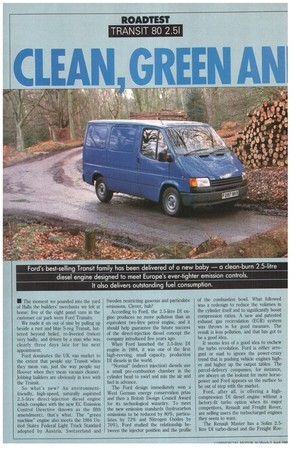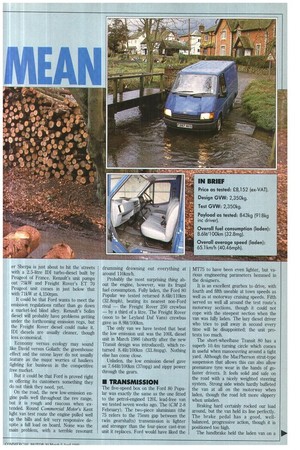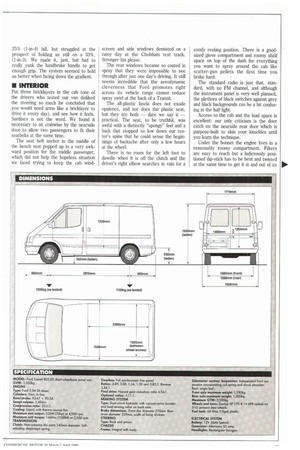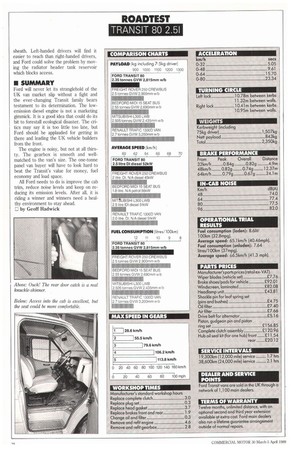CLEAN GREEN AN EAN
Page 36

Page 37

Page 39

Page 40

If you've noticed an error in this article please click here to report it so we can fix it.
Ford's best-selling Transit family has been delivered of a new baby — a clean-burn 2.5-litre diesel engine designed to meet Europe's ever-tighter emission controls. It also delivers outstanding fuel consumption.
• The moment we pounded into the yard of Halls the builders' merchants we felt at home: five of the eight panel vans in the customer car park were Ford Transits.
We made it six out of nine by pulling up beside a rust and blue S-reg Transit, battered beyond belief, re-livened (twice) very badly, and driven by a man who was clearly three days late for his next appointment.
Ford dominates the UK van market to the extent that people say Transit when they mean van, just the way people say Hoover when they mean vacuum cleaner. Jobbing builders are obviously in love with the Transit.
So what's new? An environmentfriendly, high-speed, naturally aspirated 2.5-litre direct-injection diesel engine which complies with the new EC Emission Control Directive (known as the fifth amendment), that's what. The "green machine" engine also meets the 1984 United States Federal Light Truck Standard adopted by Austria, Switzerland and
Sweden restricting gaseous and particulate emissions. Clever, huh?
According to Ford, the 2.5-litre DI engine produces no more pollution than an equivalent two-litre petrol engine, and it should help guarantee the future success of the direct-injection diesel concept the company introduced five years ago.
When Ford launched the 2.5-litre DI engine in 1984, it was one of the first high-revving, small capacity, production DI diesels in the world.
-Normal" (indirect injection) diesels use a small pre-combustion chamber in the cylinder head to swirl and mix the air and fuel in advance.
The Ford design immediately won a West German energy conservation prize and then a British Design Council Award for its technological wizardry. To meet the new emission standards (hydrocarbon emissions to be reduced by 80%, particulates by 72% and Nitrogen Oxides by 70%), Ford studied the relationship between the injector position and the profile of the combustion bowl. What followed was a redesign to reduce the volumes in the cylinder itself and to significantly boost compression ratios. A new and patented exhaust gas recirculation (EGR) system was thrown in for good measure. The result is less pollution, and that has got to be a good idea.
It seems less of a good idea to eschew the turbo revolution. Ford is either arrogant or mad to ignore the power-crazy trend that is pushing vehicle engines higher and higher up the output tables. The parcel-delivery companies, for instance, are always on the lookout for more horsepower and Ford appears on the surface to be out of step with the market.
Ford, after all, is offering a highcompression DI diesel engine without a factory-fit turbo option when its major competitors, Renault and Freight Rover, are selling users the turbocharged engines they seem to want.
The Renault Master has a Sofun 2.5litre DI turbo-diesel and the Freight Rov er Sherpa is just about to hit the 'streets with a 2.5-litre IDI turbo-diesel built by Peugeot of France. Renault's unit pumps out 75kW and Freight Rover's ET 70 Peugeot unit comes in just below that with 71kW at 4,150rpm.
It could be that Ford wants to meet the emission regulations rather than go down a market-led blind alley. Renault's Sofirn diesel will probably have problems getting under the forthcoming emission regs, but the Freight Rover diesel could make it. IDI diesels are usually cleaner, though less economical.
Economy versus ecology may sound like David versus Goliath: the greenhouse effect and the ozone layer do not usually feature as the major worries of hauliers fighting for business in the competitive free market.
But it could be that Ford is proved right in offering its customers something they do not think they need, yet.
On the road, the new low-emission engine pulls well throughout the rev range, but it is rough and raucous when extended. Round Commercial Motor's Kent light van test route the engine pulled well up the hills and felt very responsive despite a full load on board. Noise was the main problem, with a terrible resonant
drumming drowning out everything at around 110km/h.
Probably the most surprising thing about the engine, however, was its frugal fuel consumption. Fully laden, the Ford 80 Popular we tested returned 8.61it/110km (32.8mph), beating its nearest non-Ford rival — the Freight Rover 250 crewbus — by a third of a litre. The Freight Rover (soon to be Leyland Daf Vans) crewbus gave us 8.91it/100km.
The only van we have tested that beat the low emission unit was the 100L diesel unit in March 1986 (shortly after the new Transit design was introduced), which returned 8.41it/100km (33.8mpg). Nothing else has come close.
Unladen, the low emission diesel gave us 7.641it/100km (37mpg) and zippy power through the gears.
• TRANSMISSION
The five-speed box on the Ford 80 Popular was exactly the same as the one fitted to the petrol-engined 120L lead-free van we tested seven weeks ago. The (CM 2-8 February). The two-piece aluminium (the 75 refers to the 75mm gap between the twin gearshafts) transmission is lighter and stronger than the four-piece cast-iron unit it replaces. Ford would have liked the
MT75 to have been even lighter, but various engineering parameters hemmed in the designers.
It is an excellent gearbox to drive, with fourth and fifth useable at town speeds as well as at motorway cruising speeds. Fifth served us well all around the test route's motorway sections, though it could not cope with the steepest section when the van was fully laden. The lazy diesel driver who tries to pull away in second every time will be disappointed; the unit protests too much.
The short-wheelbase Transit 80 has a superb 10.4m turning circle which comes in useful when manoeuvring around a tight yard. Although the MacPherson strut-type suspension that allows this can also allow premature tyre wear in the hands of gofaster drivers. It feels solid and safe on the road with a nicely weighted steering system. Strong side winds hardly buffeted the van at all on the motorway when laden, though the road felt more slippery when unladen.
Braking hard certainly rocked our load around, but the van held its line perfectly. The brake pedal has a good, wellbalanced, progressive action, though it is positioned too high.
The handbrake held the laden van on a 25% (1-in-4) hill, but struggled at the prospect of holding us still on a 33%. (1-in-3). We made it, just, but had to really yank the handbrake handle to get enough grip. The system seemed to hold us better when facing down the gradient.
• INTERIOR
Put three bricklayers in the cab (one of the drivers who tested our van disliked the steering so much he concluded that you would need arms like a bricklayer to drive it every day), and see how it feels. Sardines is not the word. We found it necessary to sit crabwise by the nearside door to allow two passengers to fit their seatbelts at the same time.
The seat belt anchor in the middle of the bench seat popped up in a very awkward position for the middle passenger, which did not help the hopeless situation we faced trying to keep the cab wind
screen and side windows demisted on a rainy day at the Chobham test track. Stronger fan please.
The rear windows became so coated in spray that they were impossible to see through after just one day's driving. It still seems incredible that the aerodynamic cleverness that Ford promotes right across its vehicle range cannot reduce spray swirl at the back of a Transit.
The all-plastic fascia does not exude opulence, and nor does the plastic seat, but they are both — dare we say it — practical. The seat, to be truthful, was awful with a distinctly "spongy" feel and a back that stopped so low down our tester's spine that he could sense the beginnings of backache after only a few hours at the wheel.
There is no room for the left foot to dawdle when it is off the clutch and the driver's right elbow searches in vain for a comfy resting position. There is a goodsized glove compartment and roomy shelf space on top of the dash for everything you want to spray around the cab like scatter-gun pellets the first time you brake hard.
The standard radio is just that, standard, with no FM channel, and although the instrument panel is very well planned, the plethora of black switches against grey and black backgrounds can be a bit confusing in the half light.
Access to the cab and the load space is excellent: our only criticism is the door catch on the nearside rear door which is purpose-built to skin your knuckles until you learn the technique.
Under the bonnet the engine lives in a reasonably roomy compartment. Filters are easy to reach but a ludicrously positioned dip-stick has to be bent and twisted at the same time to get it in and out of its sheath. Left-handed drivers will find it easier to reach than right-handed drivers, and Ford could solve the problem by moving the radiator header tank reservoir which blocks access.
• SUMMARY
Ford will never let its stranglehold of the UK van market slip without a fight and the ever-changing Transit family bears testament to its determination. The lowemission diesel engine is not a marketing gimmick. It is a good idea that could do its bit to forestall ecological disaster. The critics may say it is too little too late, but Ford should be applauded for getting in there and leading the UK vehicle builders from the front.
The engine is noisy, but not at all thirsty. The gearbox is smooth and wellmatched to the van's size. The one-tonne panel van buyer will have to look hard to beat the Transit's value for money, fuel economy and load space.
All Ford needs to do is improve the cab trim, reduce noise levels and keep on reducing its emission levels. After all, it is riding a winner and winners need a healthy environment to stay ahead.
0 by Geoff Hadwick








































































































































